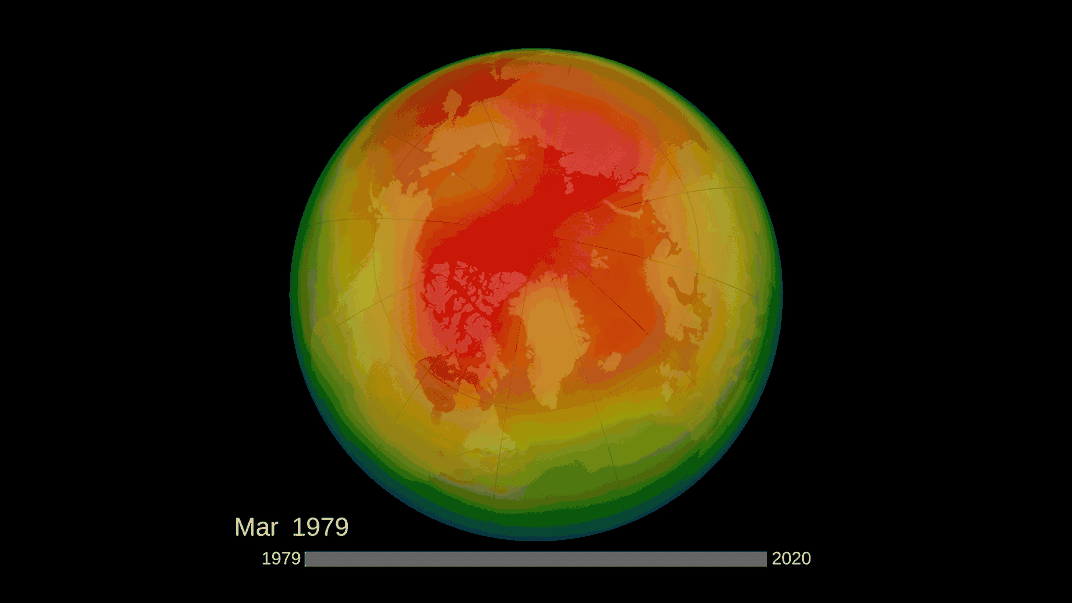Why This Rare, Huge Ozone Hole Over the Arctic Is Puzzling Scientists
The new wound further diminishes Earth’s protective shield against damaging solar radiation
:focal(129x82:130x83)/https://tf-cmsv2-smithsonianmag-media.s3.amazonaws.com/filer/dc/8e/dc8ef47a-c189-48a4-bfbd-c0886e04da86/screen_shot_2020-04-01_at_30500_pm.png)
Last week, new research declared the once-worrying fissure in the ozone layer at the South Pole to be largely vanquished. But in March, a new hole opened in the ozone, this time on the other side of the world in the atmosphere above the Arctic.
The hole will likely set a new benchmark for the largest ozone hole ever recorded in the North Pole. Fortunately, even though it’s three-times the size of Greenland, the tear is not likely to last long or be a danger to human health, reports Alexandra Witze in Nature.
Ozone is a gas made up of a trio of oxygen atoms. In the stratosphere, about 12 to 18 miles about Earth’s surface, a thin layer of ozone absorbs a portion of the ultraviolet radiation emanating from the sun. Ultraviolet radiation damages living cells by mutating their DNA, and can also cause the proteins that give cells their structure to unravel and misbehave. Humans get a taste of the dangers of solar radiation in the form of sunburns and skin cancer. A depleted ozone layer would mean getting sunburnt in just a few minutes as well as a dramatic increase in rates of skin cancer, but no ozone layer would likely render life on Earth’s surface impossible.

In 1974, scientists found that chemicals called chlorofluorocarbons, or CFCs, used in spray bottles and refrigeration destroyed ozone. In the 1980s, the discovery of a gaping hole in the ozone layer over Antarctica drew international dismay and, in 1987, culminated in the Montreal Protocol, an international agreement that largely banned the use of CFCs.
As CFC concentrations in the skies have declined, the hole in the southern hemisphere’s ozone has shrunk. But the ozone layer’s thickness over Antarctica remains naturally seasonal, and every year the region’s extremely cold winters cause the ozone layer above to wane. The plummeting temperatures give rise to high-altitude clouds suffused with the CFCs still swirling in Earth’s atmosphere, which then rasp away at the nearby ozone.
These conditions are rare in the Arctic, where it’s usually too warm and variable for the high-altitude clouds to form. But this year, temperatures dropped and strong winds whipped the cold air into a stable polar vortex that parked high-altitude clouds, along with ozone-depleting CFCs, over the North Pole, unraveling the region’s ozone.
This winter, the mass of cold air over the Arctic was more substantial than in any winter recorded since 1979, as Markus Rex, an atmospheric scientist at the Alfred Wegener Institute, tells Nature. Weather balloons measured a 90 percent drop in Arctic ozone in late March.

This rare, northerly gap in Earth’s protective layer isn’t endangering people, however. The region’s cold, dark winter is just beginning to wind down, meaning there is barely any potentially damaging sunlight shining down in the first place. The increasing daylight also means things will start to warm up. And as temperatures climb, the hole probably won’t stick around, as Martyn Chipperfield, atmospheric chemist at the University of Leeds, tells Hannah Osborne at Newsweek.
As CFCs grow scarcer in the atmosphere, the future risks of the ozone layer dangerously unzipping over either pole will also decline, Chipperfield tells Newsweek.
But scientists are still anxious to watch this rare phenomenon play out over the coming weeks. “Right now, we’re just eagerly watching what happens,” Ross Salawitch, an atmospheric scientist at the University of Maryland, tells Nature. “The game is not totally over.”
/https://tf-cmsv2-smithsonianmag-media.s3.amazonaws.com/accounts/headshot/alex.png)
/https://tf-cmsv2-smithsonianmag-media.s3.amazonaws.com/accounts/headshot/alex.png)